#Born in Kathmandu
Explore tagged Tumblr posts
Text

January 2018 PDX Portland Oregon U.S.A.
HACHI🐾✨🦴✨🐾
© KOJI ARAKI Art Works
Daily life and every small thing is the gate to the universe :)
#2018#January#January 2018#PDX#Portland#Oregon#HACHI#My family dog#family dog#Rescued dog#rescued#gsdlove#German Shepherd Dog#gsd#Born in Kathmandu#girl#dog#photographers on tumblr#b&w photography#black and white photography#monochrome photograph#original photography#photography#koji araki art works#iPhone#iPhone photography#iPhone6Plus
21 notes
·
View notes
Text
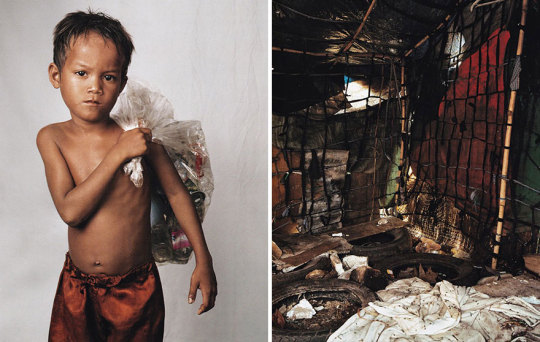
Roathy, 8, Phnom Penh, Cambodia
“Where Children Sleep” Is A Photo Series Showcasing Children’s Living Conditions Around The World
“Where Children Sleep” is a book featuring photographs taken by James Mollison, an English-born photographer, of children across the globe and their bedrooms. Initially published in 2010, the book showcases the diverse living conditions and environments in countries such as the U.S.A., Mexico, Brazil, England, Italy, Israel, Kenya, Senegal, Lesotho, Nepal, China, and India.
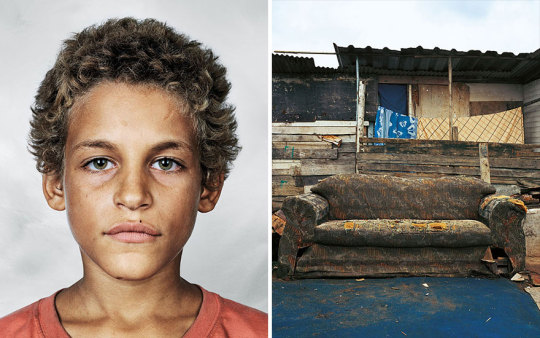
Alex, 9, Rio De Janeiro, Brazil

Lamine, 12, Bounkiling Village, Senegal
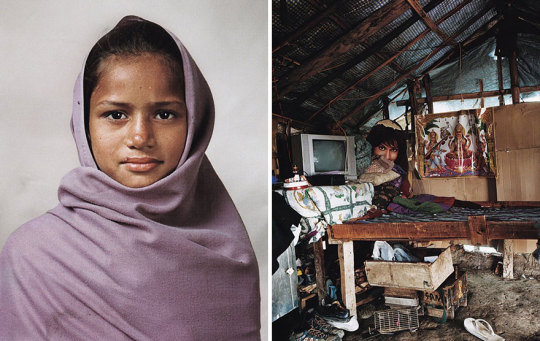
Netu, 11, Kathmandu, Nepal
#james mollison#photographer#english-born photographer#photo series#living conditions#children#portrait#non-fiction book#where children sleep#phnom penh#cambodia#rio de janeiro#brazil#bounkiling village#senegal#kathmandu#nepal#culture
3 notes
·
View notes
Text
𝐑𝐄-𝐈𝐍𝐓𝐑𝐎𝐃𝐔𝐂𝐈𝐍𝐆… 𝐌𝐘 𝐌𝐀𝐑𝐕𝐄𝐋 𝐎𝐑𝐈𝐆𝐈𝐍𝐀𝐋 𝐂𝐇𝐀𝐑𝐀𝐂𝐓𝐄𝐑, 𝐃𝐀𝐍𝐈𝐄𝐋 𝐆𝐀𝐑𝐂Í𝐀




❝ Daniel was only one in what he knew was a large amount of people who had come to Kamar Taj in an attempt to escape from the pain of their past. Born as the youngest son of one of Mexico's richest families, he had been told from almost the time he could walk how weak he was, how losing himself in the fantasy novels he loved was a waste of time, and how his older siblings were so much better than him, so much more worthy of taking over the family's business. His parents had never laid a finger on him to hurt him, but their constant insults and pointed remarks hurt just as much as any slap ever could.
And so, as soon as the clock struck midnight on his eighteenth birthday, Daniel had packed his bags and caught the first flight to Nepal. He had heard of a place there, a monastery of sorts, where people went to learn ways to cope with their trauma and pain. It was there, at Kamar Taj, that Daniel had learned the ways of the Masters of the Mystic Arts, working tirelessly to learn everything he could and become the best sorcerer he could be. The Mystic Arts was the only thing he'd ever been acknowledged to be good at, and so, he worked to become one of the best sorcerers at Kamar Taj, becoming something of a son to his leader, the Ancient One.
Then, many years later, Stephen Strange arrives in Kathmandu. A former neurosurgeon who seeks a way to heal his traumatized hands, Stephen is arrogant, sarcastic, and seems to believe he can learn everything in a day. But his clear natural talent may be their best chance of defeating Kacilius, a former student at Kamar Taj who seeks to unleash an otherworldly demon onto Earth, and so the Ancient One tasks Daniel with training the newest addition to the Masters of the Mystic Arts. Which Daniel does, because he has always been nothing if not a faithful student of the Ancient One.
While training Stephen, Daniel finds that the former surgeon is just as arrogant as he's seemed from afar. But he's also fiercely intelligent and annoyingly good-looking... and, as Kacilius ramps up his attacks and secrets about the Ancient One are brought to light, he may just be the only one Daniel can truly count on. ❞

General Taglist: @hiddenqveendom, @foxesandmagic, @artemisocs, @reyofluke-ocs, @endless-oc-creations, @stanshollaand, @ginnystilinski-reblogs, @luucypevensie, @ginger-grimm, @arrthurpendragon, @fakedatings, @impales, @claryxjackson, @dancingsunflowers-ocs, @eddysocs, @lucys-chen, @ocappreciationtag. (Also tagging @xoteajays.)
#my ocs#reintroducing my ocs#ch: daniel garcía#oc: daniel garcía#fic: strange magic#queerocs#fyeahocsofcolor#ocapp#ocappreciation#ochub#allaboutocs#fyeahmarvelocs#fyeahsuperverseocs#marvel oc#mcu oc#doctor strange oc
8 notes
·
View notes
Text


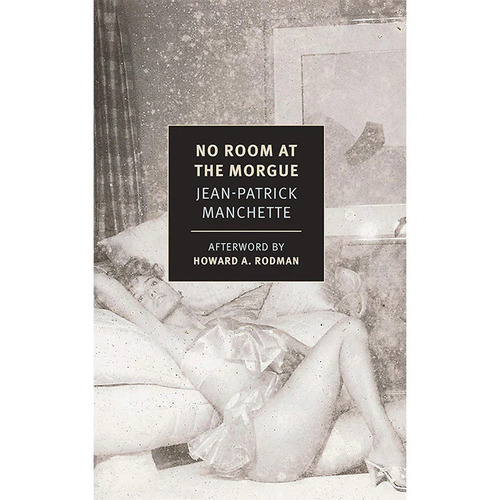
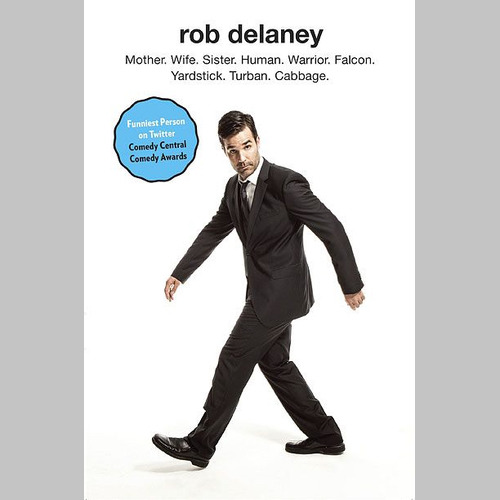



I took a long trip last fall to Singapore and Nepal. Here's some of what I read (and reread), plus a few fails, too.
The Penderwicks on Gardam Street (2nd in the series) and The Penderwicks in Spring (4th in the series) by Jeanne Birdsall.
This series has become a go-to comfort read. My daughter and I originally read this when they were a kid, and I had to dive back into it when I was missing them and my wife. I forgot how brutal The Penderwicks in Spring is, with Batty (the youngest Penderwick sister) overhearing one of her older siblings say something terrible (it involves their mother, who died just after Batty was born) and then failing to communicate with anyone about it for a while. (I reread the third book in the series earlier this year, which is why I skipped it during my trip.)
No Room at the Morgue by Jean-Patrick Manchette
Most of Machette's short crime novels (translated from French) are excellent, and there are a few graphic novel adaptations by cartoonist Jacques Tardi available in English, too. This isn't my favorite of Manchette's novels, but I enjoyed it quite a bit; it involves a down-on-his-luck detective (he's a former policeman) and a beautiful woman. It felt much more like a classic Raymond Chandler story than Manchette's other books.
Mother. Wife. Sister. Human. Warrior. Falcon. Yardstick. Turban. Cabbage. by Rob Delaney
The darkest parts of Delaney's autobiographical essays deal with his alcoholism and its consequences, but they still make me laugh out loud. I think I've read this book three or four times now. (This means I'm soon going to have to rewatch his TV series Catastrophe again in its entirety.)
Use of Weapons by Iain M. Banks.
After discovering Banks's Culture series in Kathmandu in 1999 -- it's my favorite science fiction series -- I was nostalgic for it during my recent trip to Nepal. I picked up a dusty copy in a used bookstore there, a throwback to the good old days when I had to dig though piles of paperbacks I had never heard of to find something interesting. (Now most books in the stores there are new, in plastic bags, well-organized, and almost as expensive as they'd be here.)
This book (the third in the series) is as good as I remember. It's concerned with war and soldiering and those with a natural talent for both. Rereading it I started to have the sense that I'd hated the ending when I first read it. And I was right, those last few pages suck, but I loved it right up until then. I tell you this only so you can stop reading it if you have that feeling, too.
Fails:
Maigret and the Tramp by Georges Simenon.
I've tried to read several Maigret books, but despite my love for short mysteries I haven't really enjoyed any of them. I forced myself to finish this one. I'm still not sure why they're so popular. (If you know which one of these I should start with, please tell me which that is. I have one more on my shelf, but I'll probably give it away.)
The Dog of the South by Charles Portis.
True Grit is such a great book I thought I'd read Portis's other four novels on my trip. I brought along the Library of America collection that contains them all. But reading this was like reading a well-composed joke that didn't make me laugh; I could see why it would be funny to someone, but I didn't care. I set the book aside for later.
4 notes
·
View notes
Text
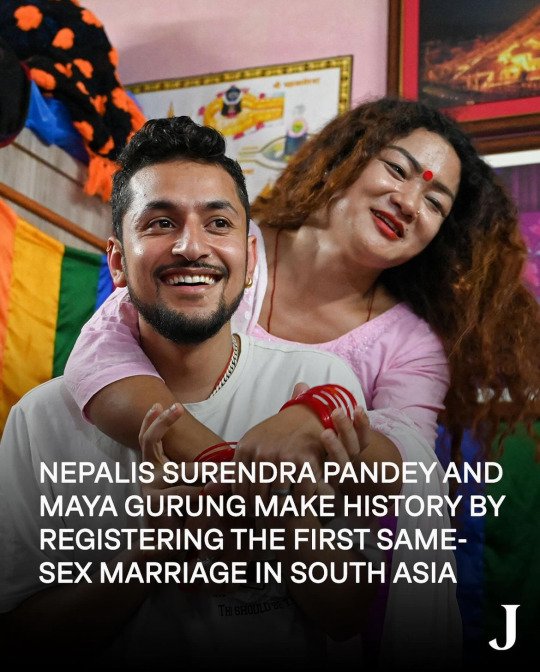
From The Juggernaut: 🏳️🌈On November 29, #Nepal became the first #SouthAsian country to register a same-sex marriage.
“Finally, we are completely together. Finally, we are completely each other’s,” Maya Gurung, 37, told The Guardian.
“We did it. We can have a beautiful future now,” Surendra Pandey, 27, told The Guardian.
In 2007, Nepal’s courts directed the government to amend laws to allow same-sex marriages, but legislators failed to bring any such amendments to Parliament. In June, Nepal’s Supreme Court issued an interim order that recognized the registry of same-sex marriages since legislators had failed to amend marriage laws.

Gurung and Pandey were married in a Hindu wedding in 2017. Gurung was born a man and identifies as a trans woman; Pandey was born a man and identifies as a man. But Nepal prohibits citizens from changing the sex assigned at birth on official documents, so the couple couldn’t open a joint bank account, buy property together, or adopt a child together.
After the Supreme Court’s interim order, the couple tried to register at the Kathmandu District Court and High Court. But they still faced pushback — until Gurung's hometown, Dordi municipality, a few miles west of #Kathmandu, stepped in and agreed to register the couple.
Nepal is the second country in Asia, after Taiwan, to recognize same-sex marriage. India’s Supreme Court refused to legalize same-sex marriage earlier this year.
“We will continue our campaign for same-sex marriage and fight to bring equality to sexual minorities in the country, so that generations of people will not have to suffer like we all did,” Gurung told reporters Friday, AP reported.
Sunil Babu Pant, a former legislator and LGBTQ+ rights activist, told AP: “It is just not same-sex marriage, but it is very inclusive…man can marry man, woman can marry woman. As we have three genders — male, female and others — others can marry others also and others can marry man [or woman].”
Read more about how India is still fighting for LGBTQ rights at the link in bio, then click this image 🔗
#same sex marriage#marriage equality#South Asia#nepal#Nepalese#lgbtqia#lgbt#queer#marriage#discrimination#queer rights#trans#India#the juggernaut#desi#qpoc#south asian
11 notes
·
View notes
Text
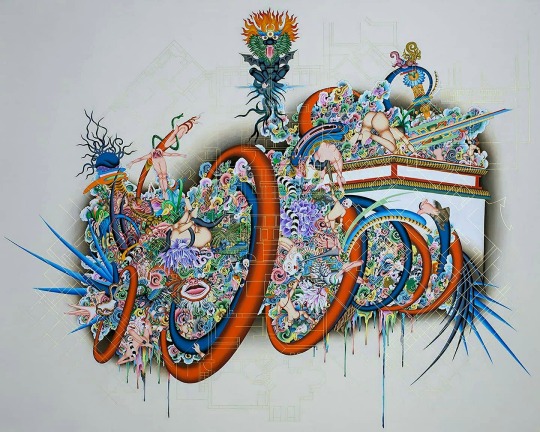
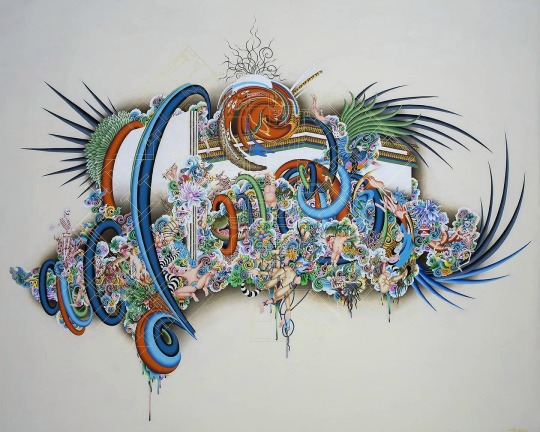
🖌🎨 Ang Tsherin Sherpa (Nepalese-born 🇳🇵🇺🇸 American)
"Born in Kathmandu, Nepal in 1968, Tsherin Sherpa currently works and resides between California, USA and Nepal. From the age of 12, he studied traditional Tibetan thangka painting with his father Master Urgen Dorje.
In 1998, Sherpa immigrated to California, where he taught traditional thangka painting at various Buddhist Centers until he began to explore his own style-reimagining tantric motifs, symbols, colors and gestures placed in resolutely contemporary compositions."
[tsherinsherpa.com]
28 notes
·
View notes
Text

Summary
This project, led by an Indian NGO Mahila Housing Sewa Trust (MHT), is on a mission to organise and empower women in low-income households to increase their resilience to impacts of climate change. To date, MHT’s initiatives have helped 25,000 low-income families across seven cities in India, Bangladesh and Nepal.
The project is centred around an integrated model wherein women take the lead through collective action and technology incubation to devise locally relevant, pro‐poor, gender-sensitive and climate-resilient solutions. For example, women were trained to be energy auditors who encourage households to switch to more efficient products, forming a women-led distribution network of green energy and building products. Other solutions include using sprinkler taps to reduce the flow of water, harvesting rainwater, and other behavioural changes leading to more than 60% of households reporting to have increase in water quantity and more than 32% having sufficient water during summers.
Though projects like these, MHT is empowering women to take action against four major climate risks: heat waves, flooding and inundation, water scarcity, and water-vector-borne diseases. These slow‐onset events attract less attention but frequently impact poor people, particularly women, the most.
Key Facts
Mahila Housing Sewa Trust (MHT) has helped organise 114 Community Action Groups, who have reached out to 27,227 women in 107 slums. Of the women they’ve worked with, 8,165 women were recorded to demonstrate an increase in “knowledge seeking behavior”.
Over 1,500 women have been trained as climate-saathis, who are responsible for communicating the issue of climate change with their community in their local language. Through this communications exercise, the proportion of participants who viewed climate change as an act of god reduced from 26 % to 9 %.
To date, around 28,000 energy audits have been undertaken in slum communities, which have saved families over USD 700,000 per annum in electricity costs. These money and energy saving interventions have included installing over 200 modular roofs and 500 roofs with solar reflective white paint, while having also led to a reduction of 105 tonnes of CO2e per annum.
The Problem
It is estimated that over 190.7 million people live in informal settlements in South Asia. These settlements are often densely populated and highly vulnerable to even the slightest changes to our climate.
MHT’s project is building the resilience capacities of over 25,000 low-income families living in slums and informal settlements across seven cities in three South Asian countries, including: Ahmedabad, Bhopal, Ranchi, Jaipur, Bhubaneswar (India); Dhaka (Bangladesh), and Kathmandu (Nepal).
Their initiatives empower women to lead local mitigation efforts to prevent key climate risks such as heatwaves, flooding and inundation, and climate change related incidences of water-vector borne diseases. These types of slow-onset events tend to attract less global attention, while also disproportionately impacting low-income households. Women are commonly the primary caregiver and responsible for household management, which renders them more vulnerable to these types of stresses.
The Solution
MHT has championed a women-led empowerment model for building climate resilience in the slums of South Asia, focused around organising groups of women in their communities. Their model builds upon the conviction that if the urban poor are provided with requisite knowledge to undertake vulnerability and risk assessments, and are equipped with available resilient‐technologies, they will be able to devise and implement locally relevant and pro‐poor, climate-resilient solutions
The project model emphasizes women taking the lead through collective action and technology incubation in order to devise these locally relevant, gender-sensitive and climate-resilient solutions. To make this possible, MHT, assists with facilitating the required infrastructure, institutional and financial mechanisms.
Helping the Planet
Through empowering women, this project is also helping reduce the emissions associated with the production of electricity in these communities. For example, one of MHT’s core initiatives trains women to become energy auditors and educate households on the nuances of energy use such as bill calculation, wattage consumption and energy wastage. As energy auditors, these women also encourage households to switch to more energy efficient products.
These trained energy auditors also act as grassroots level micro-entrepreneurs, by forming a women-led distribution network of green energy and building products. Energy auditors promote the installation of energy efficient LED bulbs and lights, modular roofs, airlite ventilator, many other solutions.
Helping People
While women from low-income families are often the most vulnerable as they have the least access to information and resources, MHT believes they also have the greatest potential to be empowered to become agents of change.
The rationale for the project is to provide these women with the requisite knowledge to undertake vulnerability and risk assessments, while also equipping them with the available climate resilient-technologies. This means they will be able to identify climate induced vulnerabilities, minimize risk and adopt locally relevant climate resilient solutions. In turn, these women also can potentially play a role in influencing better city planning and governance for pro-poor adaptation and resilience actions.
Spillover Effect
Currently, MHT is in the process of training other grassroots organisations to reproduce similar women-led groups in areas such as Bhubaneswar, Dhaka and Kathmandu.
While many other urban resilience programs are top-down and externally driven, MHT has made a concerted effort to ensure their initiatives are low-cost, contextually-appropriate and participatory. Urban poor that have been organized under this program gather critical planning data to design their own solutions and negotiate with other urban stakeholders, as well as test and manage implementation of these solutions.
Through empowering women to help improve their homes and communities, MHT’s initiatives have also triggered behavior change in communities towards making more informed decisions. This has in turn empowered them with the necessary knowledge to demand improved government services, thus proving that this concept can be expanded to other communities throughout the world.
#mahila housing trust#mahila housing sewa trust#climate resilience#south asia#women led initiatives#climate change#inequality#sorry I couldn't get it to link properly so you get the whole thing#there's a video at the content source if you're interested
12 notes
·
View notes
Text
Blog 1: First of Many
Hello! My name is Pratik, and I am a 5th-year Zoology Major and Plant Science Minor. This is the first of hopefully many blog posts that I will be writing weekly for at least the next 3 months.
My current relationship with Nature is deeply rooted in my heritage and culture. I was born in Nepal where I spent the first 12 years of my life before immigrating to Canada with my family. Nepal is a country that focuses on agriculture and tourism and houses the tallest Mountain on Earth, Mt. Everest. Most of the people I knew grew up as farmers and villagers who deeply cared about their land and natural resources. This allowed me to grow up intertwined with nature where I both respected and feared the jungles of Nepal as they are home to Bengal tigers, Indochinese rhesus macaques, leopards, wild boars, and the Big Four snakes.
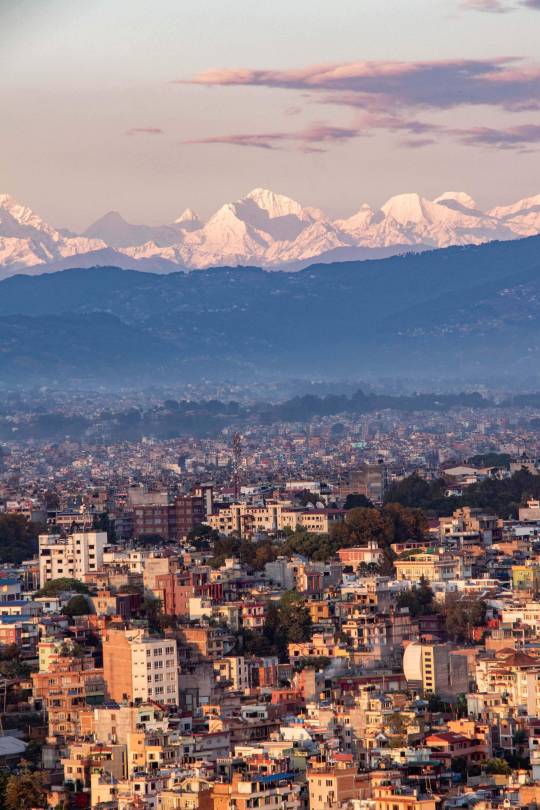
Kathmandu, Nepal where I grew up.
When I first started exploring the parks and conservation areas of Canada, I found it interesting how visitors did not fear the wildlife. This baffled me at first as I assumed Grizzly bears, cougars, and wolves roamed most of Canada and frequently clashed with the local populations like in Nepal. After doing some more research, I realized that none of the 3 animals roamed the parks near my place, and I, too, had nothing to fear like the local visitors. After 10 years in Canada, my fear of nature has eroded away, and nowadays, I frequently find myself exploring off-the-path trails and making my own path when exploring Nature. However, my respect for Nature persists as Nature, when disrespected, can be very unforgiving based on the countless tales I have heard from park naturalists, guides, and locals.
As it stands now, my relationship with Nature is built on respect and a tiny bit of fear where I plan to center my future career around Nature and Academia, hoping to make them more accessible to the public.

Holding a Garter Snake for my Field Course Paper in Algonquin Park
The two people that offered me a sense of place in Nature were Steve Irwin and Jeremy Wade. Steve Irwin was my introduction to wildlife outside of Nepal, and he taught me that wild animals, specifically snakes, are not evil by nature. They are, instead, misunderstood due to their appearance, causing humans to cull them from their local range. In Ontario, the Timber Rattlesnake was extirpated by hunters due to the snake being venomous even though conflicts were rarer than perceived. Steve Irwin showed me that wildlife does not like to be bothered, and their actions against humans are often justified (hunger, young protection, habitat loss).
Jeremy Wade was a professional angler who hosted the TV show known as River Monsters. He traveled the world, searching for freshwater-inhabiting creatures mentioned in local folklore. I remember vividly that his show was one of the first to showcase Nepal outside of the Himalayas. He showed me that the local population is more than often the most educated regarding wildlife inhabiting their lands. Jeremy would always listen to the stories of the local population and explore any leads they provided no matter how fictional they sounded. He taught me that working with the local population is the best way of studying Nature in a new environment and their opinions should not be ignored.
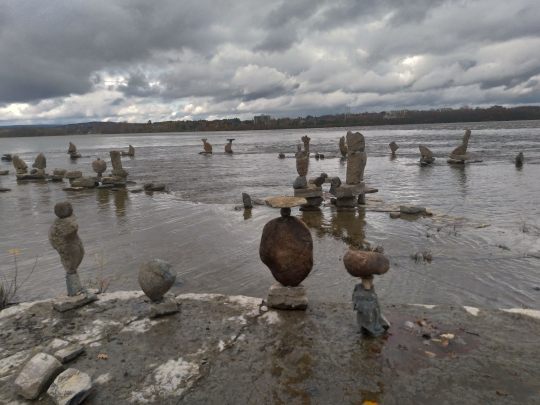
Remic Rapids Park, Oattawa
3 notes
·
View notes
Note
top 5 countries you visited?
ok, so to preface this, obviously i am going to base this on my personal experiences in the countries. i traveled to 14 countries in 2023 and some were for as short as 24 hours while others were for 2.5 weeks, so there's a really big range to choose from. but here's my list in no particular order:
001. south africa—i was born in cape town and my family moved away when i was about 18 months old which means i had no memories of my birthplace. i got to go back in may for the first time since we left and it lived up to all of my expectations. it was so beautiful and the people were lovely and i had so much fun with my colleagues and the new friends i made on the trip. i also got to go to johannesburg which was super pleasant. i got to spend a whole week in my birth country and i hope to return again in the future.
002. portugal—i went with my brother, sister, brother-in-law, and niece on a european adventure this summer and we spent a good chunk of the trip in lisbon. the city was GORGEOUS and so different from other cities i've been to before. we ate great food and drank amazing wine and had new experiences together. this was one of the first big trips my siblings and i have taken as adults and i hope we do it again in the future.
003. nepal—i lived in kathmandu for 2 years as a teenager from the time i was 14 until just after i turned 16. returning this fall for the first time since 2007 was a wild experience and so different from cape town bc i DO have so many memories from my time there. my years in kathmandu helped to shape me into the person i am today, and it was so weird to walk some of the same streets i did as a teen, to eat the same food, to smell the same air...the scent memories were insane on this trip. it felt like i'd traveled back in time.
004. ethiopia—what a wild experience! i was only in addis for about 72 hours and had some lows and highs on this trip, from spending my first night in a sketch hotel on my own before switching over to the one all my colleagues were staying in. but this trip really showed me what's possible when on these trips for work. i really bonded with one of the people in cape town, a woman named soha, and we stuck together all through the tour—normally on these trips, especially the short ones like this, i'll stick closer to the hotel and maybe go out to dinner with some people. but soha led the charge and found a cultural dance show for us to go to, and coordinated between me and another woman to do a tour around the city grabbing coffee at a famous coffee shop, visiting a church we'd driven by, going to see lucy at the national museum of ethiopia, witnessing an authentic coffee ceremony, and getting massages before my 18+ hour flight home.
005. taiwan—learning from my experience in ethiopia in the spring, this fall i took soha's lessons and put them into practice. i was in the city for maybe...48 hours? if that? but i got a bunch of recommendations from the driver who picked me up at the airport and organized a small group of us to walk to a night market and try a bunch of new food. it was such a wonderful experience in a new country and i just loved my time there.
ask me my top 5 or 20 anything of 2023
#ask#anonymous#ghana almost made the list instead of ethiopia#and south korea almost went on this list instead of taiwan
3 notes
·
View notes
Text

January 2018 PDX Portland Oregon U.S.A.
HACHI🐾✨🦴✨🐾
© KOJI ARAKI Art Works
Daily life and every small thing is the gate to the universe :)
#2018#January#January 2018#PDX#Portland#Oregon#HACHI#My family dog#family dog#Rescued dog#rescued#gsdlove#German Shepherd Dog#gsd#Born in Kathmandu#girl#dog#photographers on tumblr#b&w photography#black and white photography#monochrome photograph#original photography#photography#koji araki art works#iPhone#iPhone photography#iPhone6Plus
22 notes
·
View notes
Text
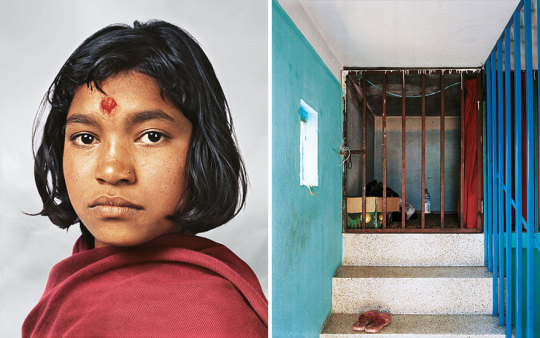
Prena, 14, Kathmandu, Nepal
“Where Children Sleep” Is A Photo Series Showcasing Children’s Living Conditions Around The World
“Where Children Sleep” is a book featuring photographs taken by James Mollison, an English-born photographer, of children across the globe and their bedrooms. Initially published in 2010, the book showcases the diverse living conditions and environments in countries such as the U.S.A., Mexico, Brazil, England, Italy, Israel, Kenya, Senegal, Lesotho, Nepal, China, and India.

Anonymous, 9, Ivory Coast
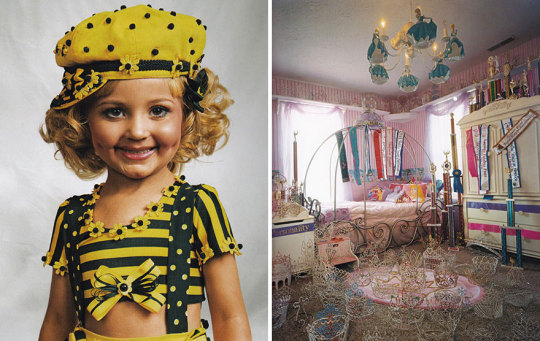
Jasmine (Jazzy), 4, Kentucky, USA

Joey, 11, Kentucky, USA
#james mollison#photographer#english-born photographer#where children sleep#non-fiction book#photo series#kathmandu#nepal#portraits#children#ivory coast#kentucky#culture
2 notes
·
View notes
Text
Nepal registers first official same-sex marriage in country
Nepal’s first same-sex marriage in the Himalayan country was registered in a village on Wednesday, officials and activists said.
It came five months after the Supreme Court had issued an interim order allowing such marriages in the largely conservative country.
The marriage between 36-year-old Ram Bahadur (Maya) Gurung, who was born male but identifies as female, and Surendra Pandey, 26, who was born and identifies as male, was formally registered at the Dordi rural municipality office in the Lumjung district in west Nepal, an official said. Pandey said in a phone interview:
“We are both very happy. Like us, all others in our community are happy too.”
The couple have been in a relationship for nine years and got married according to Hindu rituals in 2016 in the capital Kathmandu. Hem Raj Kafle, chief administrative officer of the Dordi rural municipality, said:
“We have issued the marriage registration certificate to the couple in consideration of the Supreme Court order and instructions from relevant government authorities.”
Read more HERE

#world news#world politics#news#nepal#same sex couple#same sex marriage#same sex love#same sex relationships#same sex attraction#marriage#lgbtq community#lgbtqia#lgbtq
4 notes
·
View notes
Text
TIL that Daniel Vangarde (Bangalter) went from being banned on French radio to seeing his son win album of the year and more at the Grammys. He was there when Daft Punk won everything.
Now I got to go look at the Grammy footage and see if I can see him.
transcript of the Bilboard.com article:
Daniel Vangarde, Father Of Daft Punk’s Thomas Bangalter & Disco Innovator, Breaks His Silence
From his home in Brazil, the 75-year-old legend reflects on being banned from French radio, the best advice he gave to Daft Punk and the re-release of his catalog: "I think I will not die."
Daniel Vangarde has lived a fascinating life. He’s lived at least three of them, in fact.
His first act was as a producer, A&R and all-around catalyst for some of the most popular European disco and funk acts of the 1970s and ’80s, shifting millions of copies. Since the late 2000s he’s been residing and working in a Brazilian village of 750 people, teaching English, computer literacy, vocational skills and a range of artistic expression.
Somewhere in the middle he fathered a son, Thomas Bangalter, who also made some decent records himself.
Vangarde (born Bangalter) helped guide the early movements of Daft Punk, at a time when the pre-Homework duo had magic in their fingertips but hadn’t yet mastered the close control of image and narrative which forged their mystique. Vangarde doled out critical advice to Thomas, Guy-Manuel and a coterie of close friends in the ’90s Parisian scene, instilling in them the requisite knowledge to play the industry game on their own terms and better enabling them to sculpt their consequential destiny.
Then followed a high-profile battle with France’s publishing and rights society, SACEM, over both restrictive practices for modern artists and historical aberrations for post-World War II remuneration to Jewish musicians. Sufficiently content with both his own success and the imprint he left on the next generation, Vangarde retreated into silence, only fleetingly emerging when required (including a trip to the 2014 Grammy Awards, where he watched his son clean up). There were no plans to issue communiqués with the music ecosystem — until now.
Following a deal with powerhouse French label Because Music, the vaults of Vangarde’s Zagora Records have been busted open. The resultant compilation, Daniel Vanguarde: The Vaults of Zagora Records Mastermind (1971 - 1984), out Nov. 25 on Because Music, should re-situate him in a lineage of discotheque-pleasers with a taste for suave, symphonic and Star Wars-influenced material that bristles with joie de vivre. The comp is surprisingly tight for an era which left no excess untested; it’s not a stretch to say, from the colorway of his suit down to his perm, the Daniel Vangarde peering out from the cover might just have been the model for Disco Stu.
Having undertaken the grand sum of zero English-language interviews for 75 years, Vangarde made himself available to Billboard from the deep Bahian forests for an extremely rare and rather charming conversation about it all.
One thing that’s clear across your life is a fascination with culture and society outside of your own. You produced artists from the French Antilles and the West Indies, kickstarted a cossack dance craze in the late ’60s, and latterly founded an NGO. Where does this curiosity stem from?
I always liked traveling: I spent 10 summers of my adolescence in Costa Brava [Spain], visited Swinging London, and in 1966 hitchhiked from New York down to Mexico in order to visit the Tarahumara. Life felt like an adventure.
In 1971, I happened upon Guadeloupe and loved it — the people, the place, and the local rhythmic music, biguine, which I took back to work on in Paris. Throughout trips to Kathmandu, Bali and Malaysia in the ’70s, my love for African, Arabian, South American and other music outside the French or Anglo-Saxon tradition kept growing.
What were your dreams for the world back then?
Ah, that is easy. I was curious about the globe and completely against war. I was politically active from a young age. I was arrested during the student revolution in ’68 and spent three nights in a jail cell without light. That was very frightening. They say there were no deaths but I am certain this is untrue, there was great violence. For years afterward I had to cross the street whenever I saw a policeman, you know?
You had post-traumatic stress?
Yes, yes, it was this: it was post-traumatic stress. But I stayed against nuclear factories, against the Algerian War and successfully avoided my own military service. I did not change my point of view that mass consumption is a dead-end of civilization. In 1968, we had spiritual belief in a more open future. Today we have realism about our present moment, and that is what it is.
When you were 25, you and longtime collaborator Jean Kluger came up with Yamasuki, a faux-Japanese project whose only release is still pored over by record collectors and DJs like Four Tet. Why did you decide to jump into the deep end with such a specific concept?
Listen to this article
After the success of “Casatschok,” I was mostly considered a choreographer. Shows about kung fu were beginning to sweep through television, so Kluger and I thought about creating a Japanese dance, which we called Yamasuki, but the great sound of the music caught on more. We really got into a Japanese mindset: I bought an English-to-Japanese phrasebook, we learned phonetic pronunciation and taught a children’s choir lyrics in Japanese. We even hired a karate master to deliver a shout of death [kiai] — except he had no sense of rhythm, so I would stand in the studio, cueing him when to shout… and trembling on the other side of the mic.
As disco became popular globally, and you had French artists like Cerrone winning Grammy Awards for Best New Artist, was there any competition or jealousy? Or did you regard them as your peers?
Peers, totally. There was no competition at all. If there was any competition, in fact, it was with American and English production. I never used a mastering studio; I would be there at the Phillips factory, watching the acetate get pressed, making sure the sound was impeccable. Cerrone, he was not a friend, but we would see each other at the discotheques when taking our new records to the DJ for promotion. The same applies for Jacques Morali {the disco producer responsible for the Village People] — at this time, for the French to have success away from home was a great feeling.
Some of the records you worked on were massive. “D.I.S.C.O.” was the third biggest-seller of 1980 in Germany and the fifth in the UK; the Gibson Brothers sold millions of copies; you’ve been sampled and covered by Erykah Badu, Bananarama, Roger Sanchez — it’s a legacy of success by any other name. Did that come as a surprise to you?
I will say that when I started to make songs, I wanted to write to The Beatles and tell them that there should be five members. [Laughs] I was this certain that I could bring something to them. I imagine that maybe everybody that records hopes that his music will be understood and appreciated by the public. But even if I was expecting success, I recognize it’s a great privilege to live your life off of music.
What was your relationship to fame throughout all this?
I only did one LP as a frontman, which had the privilege of being banned on radio and television. The lyrics concerned how France is the third biggest producer of bombs and mines. Of course, that’s a state secret, so the record was buried, and I was never a frontman again. But that’s alright: I was an author, composer and producer; an artisan. I sought no fame, no show business. A reporter asked me recently: “So you live your life in the shadows?” And I said, “No! I live in the light, normally, like you do.”
Interest in the Zagora reissue is however fun to me, because I was not fashionable at all. I produced La Compagnie Créole, a very big band in the ’80s, and we could sell out three nights at L’Olympia but I could never once get a journalist to come see the show. That’s just how it was then. If it’s not chanson, it’s not serious. In France, popular music is suspicious.
By the time your career wound down around 1990, was the love for music still present? Was it a creative rupture or a decision to be with your family?
Truthfully, I was not producing music that excited me, and I thought it unwise to carry on. When making a hit my hands would become wet while mixing, and a physical sensation would overtake my belly. So if I was not feeling anything, why would anyone else? Also, there was a new generation doing dance music, and of course this was very close for me.
Yes, on that note… perhaps no one in the last 10 years has done more to kickstart the revival of disco and analog production than your son, Thomas. Why do you think that era has swept back into the public consciousness?
I can see why. Nothing replaces rhythm. Songs that you can dance to, with a melody you can sing — not rap, not techno, not even Daft Punk can compete with this human response to a good feeling. There are different chapels today: you have country radio, rap radio, rock radio, but the old repertoire has maintained.
What aggregates the masses are famous hits, and disco was the last of this kind of music. When they decided that disco was over and they started to burn the records [1979’s infamous bonfire of hate, Disco Demolition], I thought it was a joke, because I never thought happy, dancing music could possibly fade. And when disco came back, I realized it hadn’t faded after all.
Your know-how helped ground not only a young Daft Punk, but also their peers Phoenix and Air, all of whom credit your advice with allowing them to navigate the music biz and retain creative freedom.
I think all artists should have this freedom. I helped Thomas, Guy-Man and their friends as much as I could to allow them to release without barriers. They were only 20 years old and the industry could have squeezed them — a normal contract generates interference between your work and the time it’s released. I made an introduction to my English lawyer, who is still [Daft Punk’s] lawyer today, and advised them not to let the author’s rights society in France authorize their music for film or publicity. My input was to help create a good environment that allowed them to produce freely.
Do you think the industry is a better place for young artists now than it was in the ’90s, or the ’70s? Or is it contingent on who you are?
That’s difficult to say. I think the music industry is in a terrible situation, not because of the internet, but because record companies and publishers didn’t know how to use the internet. When I helped Thomas set up Daft Club [a groundbreaking hub for digital downloads and fan service, released in tandem with 2001’s Discovery] even then, many considered the internet science fiction for geeks. And what was the result?
They should have contracted the hackers! The best guy from Napster should have been contracted by record companies to organize a new paid system. At a time when people paid $10-20 for an LP, of course they would have accepted paying $1 instead. But the industry did nothing, music became like free air, and once the value collapsed to zero for many years, it was hard to come back from this.
In the ’70s, the artistic directors of a record company or programmers of a radio station held all the control. So I didn’t think it was good then. But I can’t say it’s better today either. It’s difficult for true talent to break through or generate wealth in the same fashion as before.
As you’ve never given interviews, your working practice from that era is lost. I mean — Bangalter now rings with a uniqueness and star quality, so why did you use Vangarde as your professional surname?
I wanted to allow future Thomas to use Bangalter! No, I chose a pen name in case I had success; I did not wish to book a hotel or restaurant and be recognized. Why Vangarde? Originally I had prepared Morane, the name of a small French plane in the early 1900s. But on the day of registration with SACEM, this was already taken, so I was given one minute to change. I quickly thought of another plane called the Vanguard, and this stuck by complete accident.
You’ve been distant from your own catalog for so long. Why now?
I’m afraid it’s not very romantic. I have known Emmanuel [de Buretel, kingpin of French electronic music] since he was 25. When Because Music showed interest in buying Zagora Records and releasing some old tracks, I trusted them, and said, “You’ll be the owner of the catalog, so if you want to, yes.” As I have never done photos or interviews, I did not expect interest at all. I could even not remember some of their choices, so I had to go on YouTube and listen back as I was certain these were not my songs! To see any reaction has been a huge shock. Because made a very good decision.
So you never considered what you’d like your legacy to be?
I think I will not die. I have songs that I did 50 years ago that are still popular. If people are happy when they hear the songs and go to dance, or go to see the bands still touring, they do not die. This is the answer of my legacy.
And are you satisfied?
Yes, I’m very happy. I have the privilege to do what I want, and a good personal life… in the shadows. [Laughs] I have a good relationship with Thomas and now I have two grandchildren. One is 20 years old and the other is 14 — I love them. I go on being free and having my health. What more can I ask for?
15 notes
·
View notes
Text
Severance actress Dichen Lachman is going ape. Lachman, who plays a key role opposite Adam Scott in the buzzy Apple TV+ show, has joined the chest-thumping cast of Kingdom of the Planet of the Apes, 20th Century Studio’s latest Planet of the Apes movie.
The new Apes movie is set many years after the conclusion of 2017’s War for the Planet of the Apes. Many apes societies have grown from when the Moses-like Caesar brought his people to an oasis, while humans have been reduced to a feral-like existence. Some groups have never heard of Caesar, while others have contorted his teaching to build burgeoning empires.
In this setting, one ape leader begins to enslave other groups to find human technology, while another ape, who watched his clan be taken, embarks on a journey to find freedom. A young human woman becomes key to latter’s quest, although she has plans of her own.
The screenplay is by Josh Friedman, Rick Jaffa & Amanda Silver and Patrick Aison.
Shooting is underway in Australia with Freya Allan, Owen Teague, William H. Macy and Kevin Durand among the key players.
It is unclear who Dichen is playing.
The Kathmandu, Nepal-born actress played a black market dinosaur dealer in Jurassic World Dominion, which grossed over $1 billion dollars when it was released last year. She also voiced General Atitaya in Disney Animation’s Raya and the Last Dragon.
In Severance, Lachman played a wellness counselor with an unusual connection to the company worker played by Scott. The show was renewed for a second season with Lachman due to return.
Lachman is repped by Gersh, Management Production Entertainment, and Ginsburg Daniels.
10 notes
·
View notes
Text
Chapter 10: The bazaar.

-In which the daughter of the Lord of Darkness who was born with the sole purpose of destroying the universe falls in love with Peter Parker.-
Masterlist.
----------------------------------
It was the end of Sharad and the start of Shishir, the coldest months of the year, well at least in Nepal, where the usual high temperature turns chillier, but at the moment Carina's robes were enough to cover her from the changing winds as she walks the streets of Kathmandu with Stephen Strange, who naturally likes to doubt Carina's sense of direction and knowledge.
"Are you sure we're not going to get lost?" He asked for the fifth time since they had left the sanctum.
Suppressing an eye roll, Carina yawned tiredly while nodding her head, again. "I've walked these streets my entire life, Stephen, have some trust."
"I'm just being cautious, I just happen to know some people around here are not the nicest." He told her, eyes observing the streets.
"Stephen, there are bad apples everywhere in the world," Carina said, as she stopped to give a praying old woman an apple and a few coins. "But we must not be afraid, instead we should have courage and be kind."
"Who told you that one? Let me guess, The Ancient One?"
Carina shook her head, grinning up at him. "Nope, Cinderella."
"... Right," Stephen scoffs a laugh.
Thankfully, they arrived quickly and without trouble at Asan, the historic bazaar, where you can buy anything from spices to textiles, bullions, electronics and food items. The market colours were vivid and bright, which was always enticing for Carina no matter how many times she walked about the same streets.
Stephen and Carina walk past a variety of merchandise and a diverse range of products through the mass of people, a familiar woman, Chaha, caught her eye, she's the one Carina usually goes to buy her paintings, but before she turns to Stephen whose eyes were roaming around the colourful streets.
"Okay, there's a place just down the street to buy your razor, and anything else if you need," She informed him, pointing at the one store on the kiosk. "Just tell him you're from the Kamar-Taj when you get everything you need."
Stephen nods, glancing at the little store before looking down at her. "Where are you going to be?"
"Just buying a few paintings, don't worry you'll be fine, I won't be gone long." She teased him before a yawn broke out of her making her cover her mouth.
"Alright, I'm leaving." Stephen rolled his eyes, before beginning to walk away without another word leaving Carina to walk towards the shop of paintings.
"Namaste, Chaha-ji," Carina greeted the woman with a smile who smiled back. "तपाईंलाईकस्तोछ?"
"म ठिक छु, तपाईंलाई कस्तो छ?" She said, greeting her back
Carina nodded. "म ठिक छु, I'm here to buy more paintings."
"Of course, what colours you want today?" said the woman, "I have new colours, see..."
Chaha showed her plenty of 'new colours', which were the same old colour but more pigmented, Carina ended up buying the same pallet of colours as always, a new brush and a brand new sketchbook, which was much needed.
She bid the woman goodbye before going to search for Stephen, smiling at a few people she knew from her previous visit here and there.
"I'm telling you, I'm with the Kamar-Taj." Carina heard him before she arrived. Stephen was annoyed.
"No, no you pay." said the owner of the shop.
Stephen sighs. "You're not listening to me– "
"शुभ - प्रभात," Carina entered the shop, Stephen did look indeed annoyed but a quick relief passed through his eyes when he saw her. "यो मान्छे मालिकहरूको भाग हो, उसले तपाईंलाई तिर्नु पर्दैन, सर."
The man made a noise in the back of his throat, "मैले उसलाई पहिले वरिपरि देखेको छैन."
"ऊ नयाँ छ, अब म��ाई रेजर दिनुहोस्," She nudges her head at the things on the counter with a tight smile.
He sighs taking a plastic Bach from under the table and placing the stuff inside it. The man gave Stephen the plastic bag with a curious look, who took it with narrow eyes. "Thank you."
"धन्यवाद." Carina repeated, before leaving the store with Stephen following her.
"Talk about stubborn." Stephen rolled his eyes, huffing. "I told him five times that I was part of the students,"
"He said he hadn't seen you before, he was just cautious," Carina told him,
"How many people does he get wearing old robes and telling him they're from the sanctum?" He scoffs, a sarcastic end to his words.
Carina shrugged, "It's not a secret the temple pays a few stores for the exchange of goods, some people take advantage of that, not to mention that beard of yours didn't help."
"Funny." He deadpanned, "And what was I supposed to do? Show him my certificate of the sanctum or something?"
"It's neither of your faults, but now he will remember your face if you ever go back..."
Carina's eyes travel through the shops, lighting when she smelled the familiar scent.
"That'll be a hard pass–"
She grabbed Stephen's sleeve and pushed through the crowd, avoiding a few bikes on the way ignoring the man's protest and questioning.
"This is the best Chana Chatpate, and you are going to try it," Carina said, doing a short line to buy two portions.
Stephen sighs in defeat and nods. "You could have just said you wanted to come here instead of dragging me all the way."
Carina yawned, rolling her eyes. "Stop complaining, I'm hungry."
There were another two people on the line when her eyes caught the pretties pink bag she had ever seen. She turns to Stephen muttering a quick. "Stay here, I'll be back soon."
Without waiting for his response, she made a beeline to the store, which was showcasing soft silks, pretty bangles, woollen garments, artefacts and a few other things, the list is truly endless. The shop was not part of the list the sanctum paid to, meaning she needed to use her emergency money.
She approached the owner and asked. "यो झोला कति हो?" Pointing at the pink flowery bag.
The man told her the total, adding that it was a good quality bag, and that it was fashionable for young girls. Carina doubt it was, as it looked quite old, but she liked it nonetheless. It was a bit pricey but she could get it if she abstain from buying her chatpate, which she had to pay for as street food was also not on the list.
Other than the paintings, Carina never buys anything for herself, when she visits with the ancient one it was usually a quick visit as the woman was a busy person, and when she comes with Wong, he's usually telling her that 'attachment from the material is detachment from the spiritual, so she doesn't even look at anything else, but now, she's with Stephen who she was sure couldn't care less if she does buy it or not.
"ठिकै छ." She told the man, giving him the money.
When she had a hold of the pink bag, she felt a rush of excitement, a giddy feeling. It was definitely worth it, buying something for herself was so gratifying, that even her hunger went away.
Skipping back to where Stephen was making line, she got there just in time as the last person left with their food. She motions the worker for just one portion before paying, using the last of her emergency rupees.
"What about you?" Asked Stephen, once the worker gave him the food wrapped on a page of the newspaper.
Carina grinned and showed him her new pink bag, "It was this bag or food, and I felt it would feed me more if I bought the bag."
"That's an unhealthy logic," Stephen mumbled not looking impressed by her choice.
Carina brushes her fingers over the bag. "It's the first purchase I ever made for myself, Stephen, ever."
"Alright, alright." He hold his free hand up as they moved through the streets. "Good for you, then."
"It's so pretty, isn't it?"
Stephen regarded the bag, "I supposed, not my favorite color thought."
"Well, It's my favourite colour."
"And that's what's important," Stephen said before looking down at his chatpate. "Now how do I eat this?"
Carina giggles, pointing at the small chopped cardboard, "With that,"
"That's not hygienic," Stephen said, making a face.
"Try it," Carina rolled her eyes.
Hesitantly, Stephen grabbed the rectangular cardboard, scooped some chatpate on it and shoved it into his mouth. Carina watches expectantly as he chews it, face not giving anything away.
"So?" She asks when he swallows.
He looked at her and grinned softly, nodding his head. "It's pretty good."
"I told you so," She laughs triumphantly, pushing him slightly. "Never doubt me, Strange."
"Hard not to but I'll try."
As they were walking back to the temple, Carina yawned once again, making Stephen turn to her. "Did you not sleep last night?."
"I... it was just a bad night." She told him, avoiding his eyes, taking her necklace in her hand.
"Are you sure?" He asks, eyes narrowing as he places a hand on her forehead. "You look a little sick, are you coming down with something?"
"I'm fine, just a little tired that's all " She rolled her eyes, pushing his hand away.
"Okay, fine," Stephen said, turning back to his food. "You want the rest? I'm full."
Carina nodded happily, taking the paper cone from him. "Thank you."
She was glad Stephen dropped the subject because in a way she was telling the truth but in a way she was also lying, it was a bad night of sleep but not just that. It started with soft murmurs, soft undecipherable whispers that woke her up at night, Carina just wrote it off as a figment of her imagination, a short-lived nightmare, maybe she's finally experiencing PTSD after that night with the Zealots, they come every night and leave every morning. It was tiring but she'll rather keep it to herself, she'll only be a burden.
"So, there's a full moon party in a few nights, you should go," Carina said, not wanting to start thinking about the whispers. "You know, after you shave."
Stephen glanced at her, ignoring her last comment. "What's that?"
"A party we throw every other month to celebrate the completion, fertility, abundance, and transformation that the full moon brings, but in reality is just an excuse for the adults to abuse of all the Ale that the Kamar-Taj has stored and for the kids to eat all the sweets on the dessert table." She shrugged, taking a bite of the chatpate.
"I might make an appearance, do you often go to those parties?" He asked.
Carina nodded. "They always project a movie for the kids, this month is Atlantis: the lost empire, and I happen to like Disney movies."
"Yeah, I've noticed," Stephen told her, before scoffing and glancing down at her amusingly. "And who says Ale, anymore?"
"I do, it's more sophisticated."
"More like prehistoric."
A/N: Hope you enjoy the chapter. Please, tell me if you want to get tagged.
#marvel#marvel fanfiction#marvel comics#marvel cinematic universe#marvel fanfic rec#mcu#mcu fanfiction#the avengers#dr stephen strange#stephen strange#wong mcu#the ancient one#dormammu#peter parker#peter parker fanfiction#peter parker x reader#spiderman#spiderman far from home#infinity war#tony stark#steve rogers#natasha romanoff#bruce banner#end game#thor odinson#mcu loki#ragnarok spoilers#multiverse of maddness spoilers#wanda marvel#scarlet witch
6 notes
·
View notes
Text
Political Campaign Strategy of Gokul Baskota
-a political leader of Nepal
Gokul Baskota is a Nepali politician. He belongs to the political party CPN UML. He served as Minister of Communication and Information Technology of Nepal and is currently serving as the member of House of Representatives elected from Kavrepalanchok-2, province number 3 for the second term. He was born on August 29, 1970 on Kavrepalanchok district. He has spent his childhood in Kavrepalanchok. Later in his teenage days, his father shifted to Kathmandu.
Gokul Baskota is frequently known for his uncharacteristically brash attitude, using derogatory language towards political opponents, and remarks for attacking the free press. An audio clip of Baskota bargaining for 700 million in bribes with an agent of a Swiss company based on Kathmandu over the procurement of security printing for government was leaked to media outlets. He was accused of demanding Rs 700 million bribe in exchange for a contract to print e-passports in Nepal. He subsequently resigned from his ministerial position. He has opened the way for fair investigation. No any proof of guilty has found on him. Then, he shortly filed a defamation lawsuit against Mr. Vijay Mishra.
He has win the election held on Mansir-4, 2079 BS and been elected as a member of House of Representatives from Kavrepalanchok-2. He has received 45,345 votes. He beat his nearest rival Shiva Prasad Humagain of the Nepali Congress by 5,863 votes. He has been re-elected here 2nd time.
What makes him re-elected?
Many outsiders thinks, after such the blame against him of 700 million how can he again win the election. But us the residents of Kavrepalanchok-2 has eye witnessed his followers inside the Kavre and very sure of his victory again as well. The main reason most people liked him here is his truth specking capability. He appeared in media as a fighter. Every time the opponents backbite him, he faces it with weight in speech. He is a kind of manipulator as well. He knows what the people needs. He fights with the words of opponent in a funny way. So that the people don’t take much grudge on him.
Apart from this, many constructive work has been done after he elected as house of representative in kavrepalanchok. Hospital is going on under construction. Roads here are being pitched. People has got the sufficient facility of education and water supply and many more.
Beside this, he has good ability to attract the media and its audience. He has utilized the local media during the political campaign before election. He clearly knows that it is very important to utilize the local media for attracting the local audience. He knows local media works effectively in political campaigning rather the national media in his case. Because many common people listens the local media because they have more concerns in local issues rather than in national issues. Baskota has used the local media of Kavrepalanchok district to convey his messages to the audience of Kavre district.
He even reach at each one’s home and convey his messages to the voters. He mostly talks about his previous activities during the political campaign. He convey the voters that if he will again win, he will work for the betterment of Kaveli like he has done before. His good sense of humor and direct specking behavior also helps in influencing the voters. This is because most people prefer humor and direct specking person.
Conclusion
From all the above discussions, it is clearly known that Gokul Baskota effectively use the local media as a political campaign tool.
2 notes
·
View notes